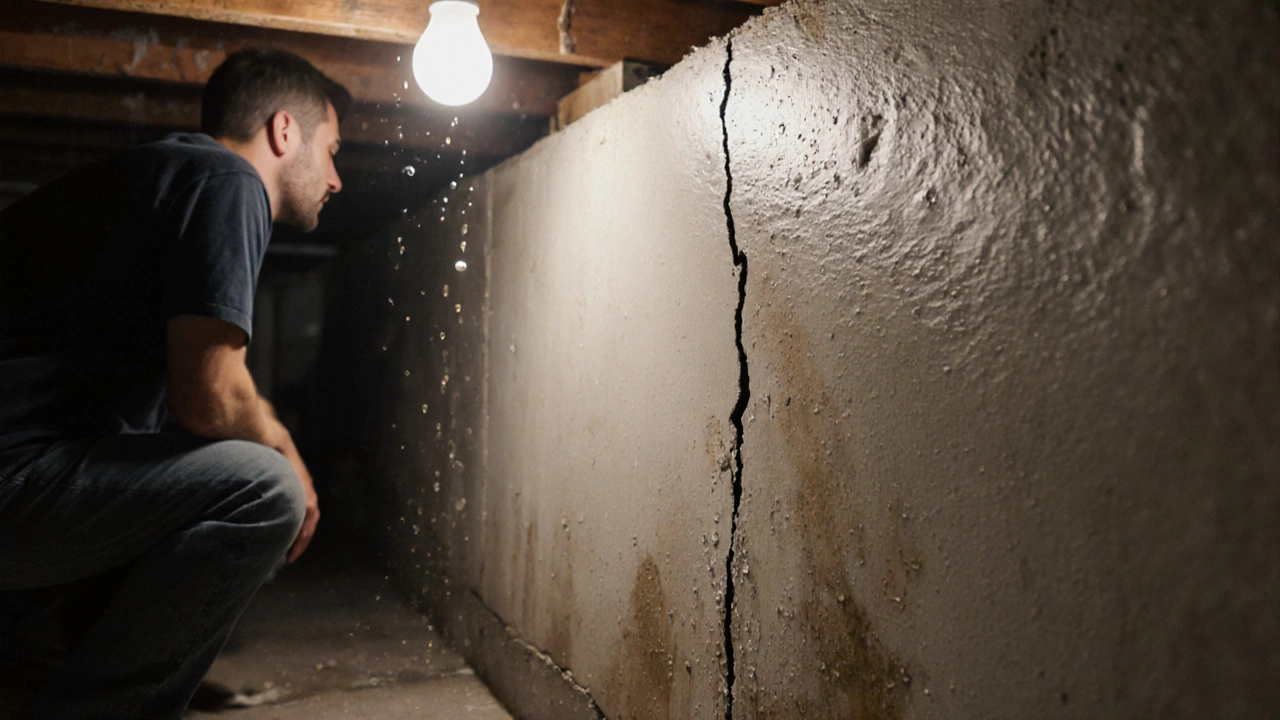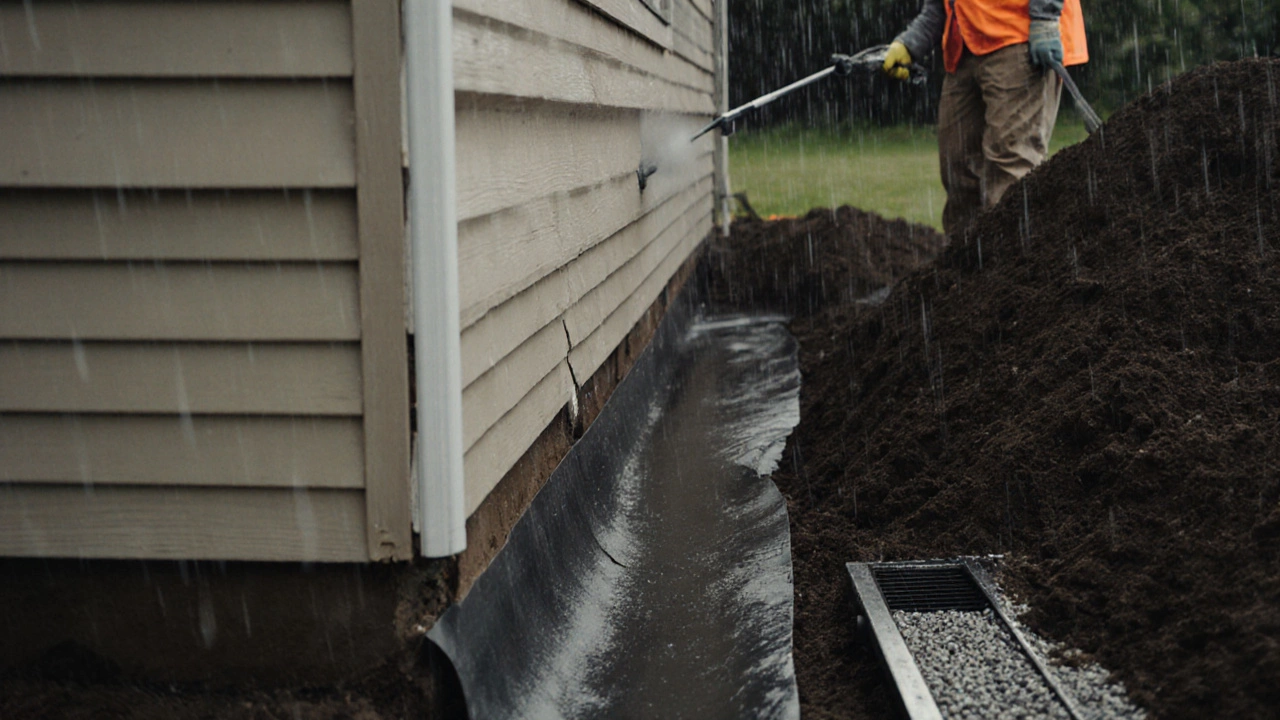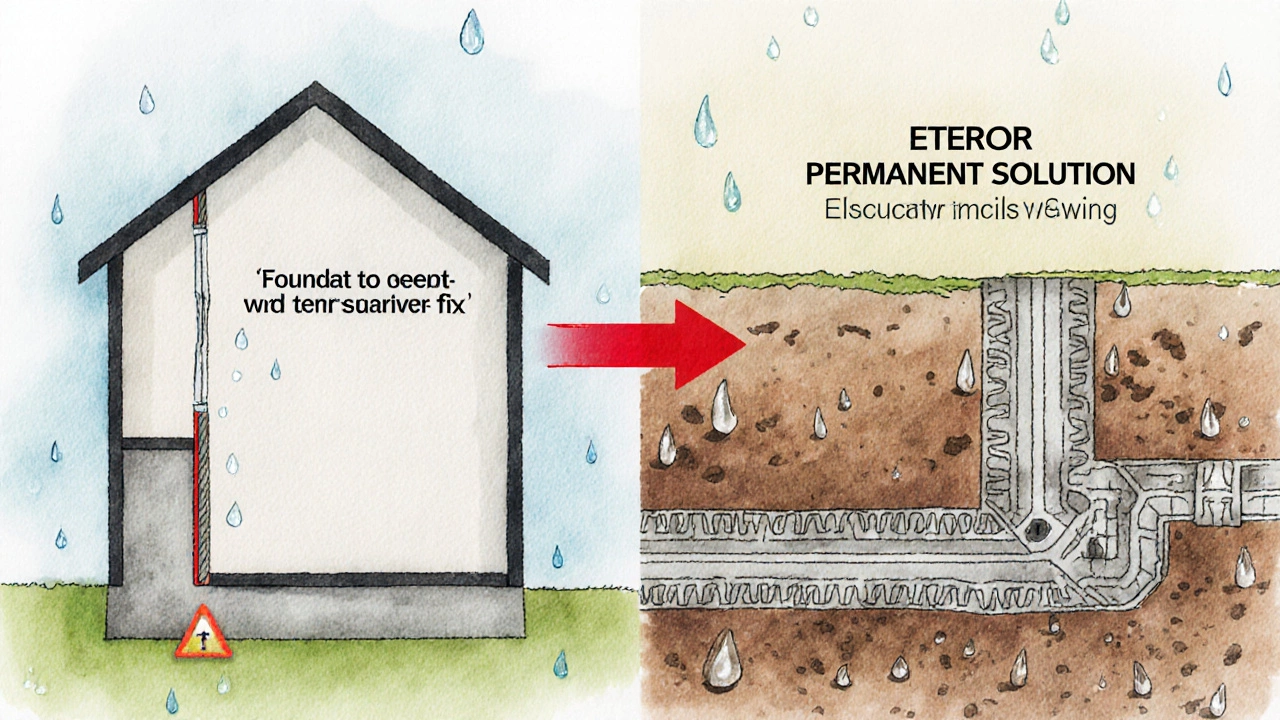Is It Better to Fix Foundation Crack from Inside or Outside?
 Nov, 23 2025
Nov, 23 2025
Foundation Crack Repair Decision Tool
Assess Your Foundation Crack
Recommended Solution
Why this recommendation?
Estimated Cost Range
When you spot a crack in your foundation, the first question isn’t just how serious it is-it’s where to fix it. Should you go inside, or tackle it from the outside? Many homeowners assume the answer is obvious, but the truth is more complicated. The right method depends on what’s causing the crack, how deep it goes, and what’s happening with the soil around your house. Getting this wrong doesn’t just waste money-it can make the problem worse.
Why Foundation Cracks Happen
Foundation cracks aren’t random. They’re the result of forces acting on your home over time. In Wellington, where the soil is often clay-rich and prone to swelling when wet and shrinking when dry, foundation movement is common. Seasonal rain, poor drainage, tree roots, or even nearby construction can shift the ground beneath your house. That movement pulls, pushes, or twists the concrete, and cracks form where the stress is strongest. There are two main types of cracks you’ll see:- Vertical cracks-usually thin, straight lines running up and down. These often come from settling or minor soil movement. They’re common and often not urgent.
- Horizontal cracks-these are serious. They usually mean the wall is bowing inward from outside pressure, like waterlogged soil pushing against it. These need immediate attention.
- Stair-step cracks-these follow the mortar lines in brick or block foundations. They signal uneven settling and can point to deeper structural issues.
Before you decide where to fix it, you need to know why it happened. Fixing the crack without fixing the cause is like putting a bandage on a broken bone.
Fixing from the Inside: Pros and Cons
Working from the inside is the most common approach for homeowners. It’s less disruptive, cheaper upfront, and doesn’t require digging up your yard. Here’s how it usually works:- Inject epoxy or polyurethane foam into the crack to seal it from within.
- Apply a waterproof coating or membrane to the interior wall surface.
- Install interior drainage systems, like French drains along the base of the foundation.
These methods are great for stopping water from seeping through small cracks and preventing mold or mildew inside your basement. Epoxy injections are strong-they bond with the concrete and restore structural integrity in non-load-bearing cracks. Polyurethane expands to fill gaps and can handle minor movement.
But here’s the catch: fixing from the inside doesn’t stop water from entering the soil around your foundation. It just catches it after it gets in. If your soil stays saturated, pressure builds up. That pressure doesn’t disappear-it just finds another way in, maybe a new crack next year.
Also, interior repairs can’t fix bowing walls. If your foundation is pushing inward, no epoxy will hold it in place. You need external support.
Fixing from the Outside: Pros and Cons
External repairs are more invasive-but often more effective long-term. This means excavating around your foundation, cleaning the wall, applying waterproofing, and installing drainage systems outside.- Excavate soil down to the footing (usually 2-6 feet deep).
- Clean and repair the foundation wall surface.
- Apply a rubberized membrane or spray-on waterproofing.
- Install exterior drainage tiles (French drains) and direct water away from the house.
- Backfill with gravel, not soil, to improve drainage.
This approach tackles the problem at its source. By keeping water away from the foundation, you reduce hydrostatic pressure-the main cause of cracks and bowing. It’s the only way to properly repair a bowing wall. Steel or carbon fiber straps can be bolted to the outside, pulling the wall back into place.
The downside? It’s expensive. You’re talking $10,000-$25,000 in Wellington, depending on house size and soil conditions. It’s messy. Your garden, patio, or driveway might need to be dug up. And if your house is close to a neighbor’s property, you might need permission to access the boundary line.
But if you plan to stay in your home for more than five years, or if you’re selling and want to avoid disclosure issues, external repair is the only truly permanent solution.

When to Choose Inside Repair
You should consider interior repair if:- The crack is less than 1/8 inch wide and vertical.
- There’s no water pressure pushing the wall inward.
- You’re seeing minor seepage, not flooding.
- Your budget is tight and you need a quick fix.
- You’re renting or plan to move within a few years.
Interior repairs are also the only option if your home has a concrete patio, driveway, or landscaping right up against the foundation-where digging isn’t possible.
But don’t let cost fool you. A $2,000 epoxy job might save you money now, but if the problem returns in two years, you’ll pay again. And if you later discover the crack was a symptom of deeper issues, you might have to do the expensive external fix anyway.
When to Choose Outside Repair
Go external if:- The crack is horizontal or wider than 1/4 inch.
- You see bowing walls or gaps between the foundation and floor.
- Water pools near your foundation after rain.
- You’ve had recurring dampness or mold in the basement.
- You’re planning to sell or refinance-lenders often require documented repairs.
In Wellington, where winter rains are heavy and soil stays wet for months, external drainage is often the only way to keep your foundation dry year-round. A properly installed exterior system can last 20-30 years with minimal maintenance.
Many homeowners in the region regret waiting. One client in Hataitai had a 3mm vertical crack. She got it injected from the inside for $1,800. Six months later, the same area was leaking again-this time with a 2cm horizontal crack. The repair cost $19,000. She didn’t know the crack was a warning sign.
What Most Contractors Won’t Tell You
Not all foundation repair companies are honest. Some push interior fixes because they’re faster and more profitable. Others avoid external work because it’s labor-intensive and risky.Ask for:
- A written assessment of the crack type and cause-not just a quote.
- Photos of the crack taken from both inside and outside.
- Proof of licensing and insurance (especially for excavation work).
- A warranty that covers both the repair and the underlying cause.
Reputable companies in Wellington will send out a structural engineer or certified inspector before giving you a quote. They’ll check soil moisture, drainage patterns, and even nearby trees. If a contractor says, “We can fix it in a day for $1,500,” walk away.

What About Both?
Sometimes, the best solution is a combination. For example:- Install an exterior French drain to redirect water away from the house.
- Then, inject the crack from the inside to seal any remaining moisture paths.
This dual approach is common in homes with older foundations and poor original drainage. It’s not always necessary-but if you’ve got both water pressure and minor seepage, it’s the most thorough fix.
Don’t assume you need both. But don’t assume one is enough either. Let the cause guide you, not the price tag.
Prevention Is the Real Winner
No matter which method you choose, the best foundation repair is the one you never need. Here’s how to prevent cracks before they start:- Keep gutters clean and downspouts extended at least 6 feet from the foundation.
- Grade your yard so water flows away from the house-not toward it.
- Plant trees at least 10 feet from the foundation. Roots can lift or dry out soil unevenly.
- Check for pooling water after heavy rain. If water sits for more than 2 hours, you’ve got a drainage problem.
- Have your foundation inspected every 3-5 years, especially if you’re in a hilly or clay-heavy area like Wellington.
These steps cost next to nothing. But they can save you thousands.
Can I fix a foundation crack myself?
You can seal small, non-structural cracks with DIY epoxy kits, but only if the crack is less than 1/8 inch wide and not leaking under pressure. If you see water coming in, the wall is bowing, or the crack is wider than a pencil, don’t risk it. Foundation issues can lead to structural failure. What looks like a simple fix can become a $20,000 problem if done wrong.
Will insurance cover foundation crack repair?
Most home insurance policies in New Zealand don’t cover foundation damage from gradual settling, soil movement, or poor drainage. They only pay out if the damage is caused by a sudden event like a landslide, earthquake, or burst pipe. Foundation repair is usually considered a maintenance issue, not an insured event. Always check your policy wording.
How long does foundation repair last?
Interior epoxy repairs can last 10-15 years if the underlying cause is fixed. But if water pressure remains, they often fail within 2-5 years. External repairs with proper drainage and waterproofing can last 25-30 years or more. The key isn’t the material-it’s whether the root cause (water, soil pressure, poor drainage) is addressed.
Does fixing from the outside always require digging up my yard?
Yes, external repairs require excavation around the foundation. But the amount depends on the problem. For a small section, they might only dig 3-4 feet along one wall. For full perimeter work, they’ll need to clear the entire base. You’ll lose plants, paving, or fencing in that zone. Replanting and restoring the landscape is usually included in the quote.
What’s the average cost difference between inside and outside repair in Wellington?
Interior repairs typically cost between $1,500 and $5,000, depending on the number of cracks and the method used. External repairs range from $10,000 to $25,000, depending on house size, depth of excavation, and whether drainage systems are installed. The exterior option costs more upfront but often saves money long-term by preventing recurring damage.
Final Decision: What Should You Do?
If your foundation crack is small, dry, and hasn’t grown in the last year, a quick interior fix might be enough-for now. But if water is involved, the wall is shifting, or you’ve had the same crack repaired before, don’t gamble. Go outside. The soil doesn’t care if it’s expensive or messy. It’s still pushing. And if you ignore it, your house will pay the price.Foundation repair isn’t about choosing the cheapest option. It’s about choosing the one that lasts. In Wellington’s wet climate, that means dealing with water before it gets to your walls-not after.
